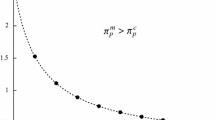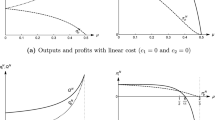Abstract
We introduce a firm partially owned by the government in a dynamic model of collusion between a subset of private firms. We show that increasing the public ownership of the non-colluding firm may help collusion between the private firms.




Similar content being viewed by others
Notes
For example, in a context of mixed oligopoly, Cremer et al. (1991) and Matsushima and Matsumura (2003) consider the locational choices of firms, Cato and Matsumura (2013) consider taxation, Matsumura (1998) considers the optimal degree of privatization, Ishibashi and Matsumura (2006), Heywood and Ye (2009) and Gil-Moltò et al. (2011) study R&D competition between public and private firms, whereas Matsumura and Ogawa (2012) and Scrimitore (2013) analyse the choice of the strategic variable. For a survey of theoretical issues about mixed oligopolies, see for example De Fraja and Delbono (1990) or Ishibashi and Matsumura (2006), while empirical investigations can be found in Megginson and Netter (2001).
One exception is a recent work by Delbono and Lambertini (2014), where it is shown that the threat of nationalizing one private firm may act as device to reduce the incentive of the remaining private firms to constitute a cartel.
We refer to semi-public firm, as we allow for the possibility that the government holds a positive proportion of the shares of Firm X (see later). As a limit case, the government entirely owns the firm. In this case Firm X is a pure public firm.
All the results in this section can be replicated for the case of quadratic costs, which are commonly adopted in the mixed oligopoly literature (see for example De Fraja and Delbono 1989; Fjell and Pal 1996). Details are available by the author upon request. In general, constant marginal costs and increasing marginal costs yield similar results. However, Matsumura and Okamura (2015) show an example where the results depend on the type of the cost function adopted. Therefore, robustness check for quadratic costs is important when considering mixed oligopolies.
Therefore, we assume a monopolistic sector with three firms producing differentiated goods, and a competitive numeraire sector.
When \(\gamma =1\), the demand functions cannot be defined. For details, see Singh and Vives (1984).
We are assuming that Firm X does not participate to the cartel, even if it may be profitable for it to participate to the agreement. This can be rationalized as follows. As noted for example by Escrihuela-Villar (2008), collusion is much easier between similar firms. As Firm X’s objective function is different from the objective function of Firm 1 and Firm 2, including Firm X into the cartel might imply excessive coordination costs (Thomadsen and Rhee 2007; Colombo 2013) and the agreement may not be reached. Note that our model extends Escrihuela-Villar (2008), by assuming that the non-colluding firm may be a public or semi-public firm.
It is well known that other more sophisticated punishment mechanisms may exist. In particular, simple penal codes as in Abreu (1986, 1988) with stick-and-carrot phases may be preferred (in the sense that they allow expanding the discount factor set that supports collusion in equilibrium). However, the simple two-phase penal code derived in Abreu (1986) for the case of quantity firms cannot be easily transferred to the present model for two reasons. First, the optimality of the penal code in Abreu (1986) is shown under the assumption of simultaneous moves by the players, while here, during the collusive phase, a sequential play occurs. Second, using the optimal penal code at least for the limit case where all firms collude (as done for example in Escrihuela-Villar 2008), is of limited interest here, as it is possible only in the case where the semi-public firm is not active. Furthermore, the grim-trigger strategy is the most popular formulation, and it has been adopted in several papers, as for example Gupta and Venkatu (2002), Matsumura and Matsushima (2005) and Ishibashi and Shimizu (2010).
In particular, when \(\gamma \le 1/2\), \(\delta ^{*} \) strictly increases with \(\theta \); instead, \(\delta ^{*} \) strictly decreases with \(\theta \) only when \(\gamma =1\).
We are assuming that the “switching” private firm does not collude.
The explicit expressions of the profits and the critical discount factor are not reported here and they are available upon request.
Note that the best-reply function of both the semi-public firm and the non-colluding private firms takes into account the fact that one of the cartel’s members has deviated.
The following numerical example has been repeated with different values of N. Details are available upon request.
The complete expression of the critical discount factor is omitted from the text as it is quite long.
We assume that the government owns the same share in both the semi-public firms.
Note that \(\partial {\pi _k^D }/ {\partial \theta }-\partial {\pi _k^C }/{\partial \theta }<0\).
Note that the government chooses \(\theta \) in order to maximize W rather than \(\Gamma \).
References
Abreu D (1986) Extremal equilibria of oligopolistic supergames. J Econ Theory 39:191–225
Abreu D (1988) On the theory of infinitely repeated games with discounting. Econometrica 56:383–396
Albaek S, Lambertini L (2004) Price vs quantity in duopoly supergames with close substitutes. Ann Reg Sci 38:567–577
Bose A, Gupta B (2013) Mixed markets in bilateral monopoly. J Econ 110:141–164
Cato S, Matsumura T (2012) Long-run effects of foreign penetration on privatization policies. J Inst Theor Econ 168:444–454
Cato S, Matsumura T (2013) Long-run effects of tax policies in a mixed market. FinanzArchiv/Public Fin Anal 69:215–240
Chang MH (1991) The effects of product differentiation on collusive pricing. Int J Ind Organ 9:453–470
Chang MH (1992) Intertemporal product choice and its effects on collusive firm behaviour. Int Econ Rev 33:773–793
Colombo S (2011) Pricing policy and partial collusion. J Ind Compet Trade 11:325–349
Colombo S (2013) Product differentiation and collusion sustainability when collusion is costly. Market Sci 32:669–674
Cremer H, Marchand M, Thisse JF (1991) Mixed oligopoly with differentiated products. Int J Ind Organ 9:43–53
De Fraja G, Delbono F (1989) Alternative strategies of a public enterprise in oligopoly. Oxford Econ Pap 41:302–311
De Fraja G, Delbono F (1990) Game theoretic models of mixed oligopoly. J Econ Surv 4:1–17
Delbono F, Lambertini L (2014) Nationalization as credible threat against tacit collusion. Università di Bologna, Quaderni, Working Paper DSE N.\(^{\circ }\) 972
Dijkgraaf E, Gradus R (2007) Collusion in the Dutch waste collection market. Local Govern Stud 33:573–588
Dixit A (1979) A model of duopoly suggesting a theory of entry barriers. Bell J Econ 10:20–32
Escrihuela-Villar M (2008) Partial coordination and mergers among quantity-setting firms. Int J Ind Organ 26:803–810
Fjell K, Pal D (1996) A mixed oligopoly in the presence of foreign private firms. Can J Econ 29:737–743
Friedman JW (1971) A non-cooperative equilibrium for super-games. Rev Econ Stud 38:1–12
Friedman JW, Thisse JF (1993) Partial collusion fosters minimum product differentiation. RAND J Econ 24:631–645
Fujiwara K (2007) Partial privatization in a differentiated mixed oligopoly. J Econ 92:51–65
Gil-Moltò MJ, Poyago-Theotoky J, Zikos V (2011) R&D subsidies, spillovers and privatization in mixed markets. South Econ J 78:233–255
Gupta B, Venkatu G (2002) Tacit collusion in a spatial model with delivered pricing. J Econ 76:49–64
Hackner J (1995) Endogenous product design in an infinitely repeated game. Int J Ind Organ 13:277–299
Haraguchi J, Matsumura T (2015) Cournot–Bertrand comparison in a mixed oligopoly. J Econ. doi:10.1007/s00712-015-0452-6
Heywood J, Ye G (2009) Partial privatization in a mixed duopoly with R&D rivalry. Bull Econ Res 61:165–178
Ishibashi I, Matsumura T (2006) R&D competition between public and private sectors. Eur Econ Rev 50:1347–1366
Ishibashi I, Shimizu D (2010) Collusive behavior under a leniency program. J Econ 101:169–183
Lambertini L, Schultz C (2003) Price or quantity in tacit collusion? Econ Lett 78:131–137
Martin S (2010) Industrial organization in context. Oxford University Press, Oxford
Matsushima N, Matsumura T (2003) Mixed oligopoly and spatial agglomeration. Can J Econ 36:62–87
Matsumura T (1998) Partial privatization in mixed duopoly. J Publ Econ 70:473–483
Matsumura T, Kanda O (2005) Mixed oligopoly at free entry markets. J Econ 84:27–48
Matsumura T, Matsushima N (2005) Cartel stability in a delivered pricing oligopoly. J Econ 86:259–292
Matsumura T, Ogawa A (2012) Price versus quantity in a mixed duopoly. Econ Lett 116:174–177
Matsumura T, Okamura M (2015) Competition and privatization policies revisited: the payoff interdependence approach. J Econ 116:137–150
Matsumura T, Okumura Y (2013) Privatization neutrality theorem revisited. Econ Lett 118:324–326
Megginson WL, Netter JM (2001) From state to market: a survey of empirical studies on privatization. J Econ Lit 39:321–389
Merrill WC, Schneider N (1966) Government firms in oligopoly industries: a short run analysis. Q J Econ 80:400–412
Morasch K (2000) Strategic alliances as Stackelberg cartels—concept and equilibrium alliance structure. Int J Ind Organ 18:257–282
Motta M, Polo M (2003) Leniency program and cartel prosecution. Int J Ind Organ 21:347–379
Posada P, Straume OR (2004) Merger, partial collusion and relocation. J Econ 83:243–265
Scrimitore M (2013) Price or quantity? The strategic choice of subsidized firms in a mixed duopoly. Econ Lett 118:337–341
Shaffer S (1995) Stable cartels with a Cournot fringe. South Econ J 61:744–754
Singh N, Vives X (1984) Price and quantity competition in a differentiated duopoly. RAND J Econ 15:546–554
Thomadsen R, Rhee KE (2007) Costly collusion in differentiated industries. Market Sci 26:660–665
Author information
Authors and Affiliations
Corresponding author
Additional information
I would like to thank the Editor Giacomo Corneo and three anonymous reviewers whose suggestions greatly improved this work. I wish to thank Toshihiro Matsumura, Luigi Filippini, Noriaki Matsushima, Akira Ogawa, Nicola Doni, Federico Boffa, Lucia Visconti Parisio, Bruno Bosco, Vittoria Cerasi, Johannes Meya and participants to XVI Centre for competition and regulatory policy workshop in Milan (Italy), and SIDE-ISLE 9\(\mathrm{th}\) Annual Conference, Lugano. All remaining errors are my own.
Rights and permissions
About this article
Cite this article
Colombo, S. Mixed oligopolies and collusion. J Econ 118, 167–184 (2016). https://doi.org/10.1007/s00712-015-0467-z
Received:
Accepted:
Published:
Issue Date:
DOI: https://doi.org/10.1007/s00712-015-0467-z




